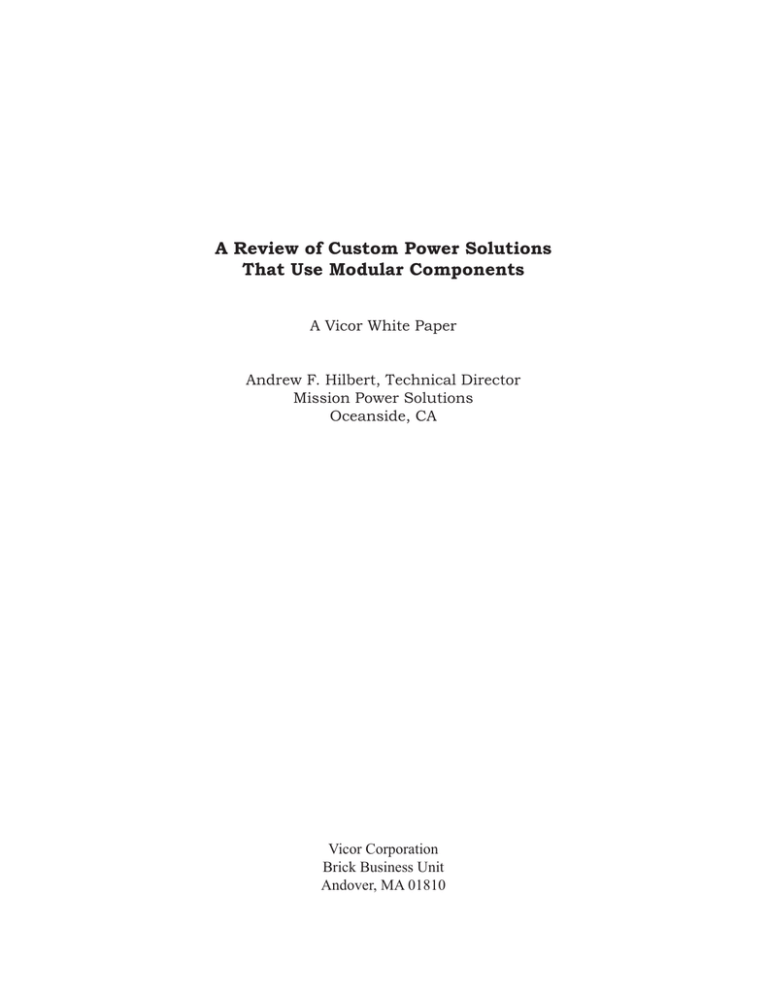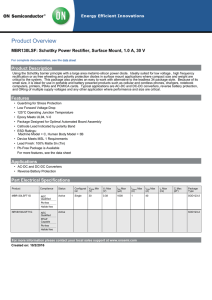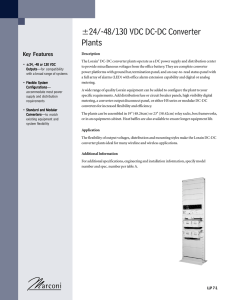Custom Power White Paper:Layout 1
advertisement

A Review of Custom Power Solutions That Use Modular Components A Vicor White Paper Andrew F. Hilbert, Technical Director Mission Power Solutions Oceanside, CA Vicor Corporation Brick Business Unit Andover, MA 01810 Foreword Custom power solutions have traditionally been the choice of electronic OEMs and, in fact, they continue to be the dominant approach, especially by those with high-volume requirements. Now, however, a growing number of electronic OEMs are opting for custom power solutions built with modular power components that provide full-blown turnkey custom power solutions. Three classes of custom power solutions using modular power components are reviewed, and a real-world example of turnkey power design and manufacturing is described. Andrew F. Hilbert, Technical Director, Mission Power Solutions, Oceanside, CA, has over 30 years of technical and management experience with power products and technologies. He can be reached at mpwrs.com. Table of Contents Introduction Different Paths to Custom Power Power Modules with Discrete Components Configurable Power Solutions Turnkey Power Solutions A Real-World Example of Turnkey Power Design and Manufacturing Regional Design and Manufacturing Centers World-Class Application Engineering Support Automated Module Design Tools Wide Design Experience List of Illustrations and Tables Figure 1. DC-DC converters come in a number of physical sizes and a wide range of input and output voltages and power levels that, when combined with discrete components, satisfy a multitude of requirements. 2. One example of a configurable power supply is this power-factor-corrected AC-DC switcher which provides up to 2,400 Watts and as many isolated outputs. 3. Turnkey power solutions also employ the full range of available power components, but this approach is completely unrestrained with respect to unique features, form factor, and packaging. Table 1 Selected examples of Vicor turnkey power solutions using power components Introduction Historically, most OEM power system requirements have been — and continue to be — met by custom power supplies. A custom power supply is, by one definition, a one-of-a-kind power solution, designed and built from scratch using discrete components to serve a specific application. Moreover, the design can truly be optimized for the specific application, designing in only what’s needed and nothing more. Such designs require a substantial amount of development time and up-front expense, but in spite of its high initial expense, such an approach is usually easy to justify when high quantities are involved, because those high initial expenses can be amortized over many units. Fundamentally, power designers who turn to a custom power supply want the specific inputs and outputs they need configured to best fit their application. Although the desire for a conventional custom system still exists, many power system architects have neither the time to wait nor the volume over which to amortize the non-recurring expense of a custom system. What’s more, they often need to satisfy other conflicting requirements such as quick time to market, low risk, high system availability, and cost effective life cycle. Another important reason that the traditional approach to designing and developing a custom power solution is losing popularity is that engineering design resources are becoming increasingly scarce, expensive, and specialized, which is making this approach less attractive every day. In the end, traditional custom power solutions will not be economically viable in this age of fast time to market, lower prices, high availability, and high reliability. Fortunately, other forms of custom power have become available that provide all of the benefits of a traditional custom power supply and then some. Different Paths to Custom Power In recent years, custom power manufacturers using component power in a modular, building-block design approach emerged to design and manufacture custom power systems that offered low cost, quick turnaround, and reliable performance. Manufacturers have sought to meet these unique power requirements while avoiding the downsides of a traditional custom solution by offering a number of power component based solutions. In general, they fall into three classes: • Power modules with discrete components • Configurable power solutions • Turnkey power solutions. Power Modules with Discrete Components: High-density component power and distributed power have earned acceptance in commercial and defense applications where high performance, reliability, and low cost are critical. DC-DC converter modules (Figure 1), commonly referred to as bricks, are available in a range of sizes and formats (e.g., half bricks, quarter bricks, etc.). Manufacturers of high-density DC-DC converters are providing power system architects with a wide range of choices. These converters — usually characterized by high-frequency operation allowing them to achieve their small size, high power density, and efficiency — come in thousands of combinations of input voltage, output voltage, and power level. Such a modular DC-DC converter, in combination with discrete components, can satisfy many unique power requirements. Because each module is a proven performer, prequalified with its own agency approvals, designers using these converters enjoy an advanced starting point toward a finished power supply. A major consideration with this approach, however, is that in-house engineering design resources are required. Figure 1. DC-DC converters come in a number of physical sizes and a wide range of input and output voltages and power levels that, when combined with discrete components, satisfy a multitude of requirements. Typical input voltages include 12, 24, 28, 36, 48, 50, 72,150, 270, 300 and 375 Vdc, although only a few manufacturers address such a wide range. Typical output voltages include 1.8, 2, 2.5, 3.3, 5, 12, 15, 24, 28, and 48 Vdc. Contributing to the ability of power components to satisfy even unusual output voltage requirements, most DC-DC converters can be trimmed, some as much as -90% to +10% of the nominal output. In the beginning, designers had to supplement the capabilities of modular DC-DC converters by using discrete components to implement auxiliary power system features such as AC-DC rectification, filtering, power factor correction, etc. That option is still open to them, but now, specialized accessory components are increasingly available. Together with the power components, these matched, compatible accessories — such as filters, holdup capacitors, heat sinks, and AC front ends — allow users to quickly assemble complete power systems by selecting and interconnecting standard, modular parts to meet their design requirements. Compatible front-end accessories, for example, provide a number of performance features such as input transient protection, EMI filtering and inrush current limiting. In addition, they have international agency approvals and can accommodate the wide range of input source voltages necessary to reach worldwide defense markets. Configurable Power Solutions. As with the power components, configurable power supplies are flexible pre-designed power solutions. Configurable power supplies are usually the fastest solutions because pre configured chassis are already on the shelf, ready to be populated with application-specific modules. They are also very cost effective with no NRE and are inherently low risk. Configurable power solutions, however, offer limited packaging flexibility. In a typical package configuration (see Figure 2), the designer selects the chassis appropriate to their input requirements and the total power level needed. A wide variety of slide-in DC-DC converter module cards are available with which the desired output voltages and currents can be configured. Module cards can be easily added or replaced, allowing the user to alter the system to meet changing or expanding needs. Individual module cards can provide up to 600 Watts of power and can be combined in parallel for even higher powers. Complete systems may be configured at the factory or, in many cases, on site by the user. Figure 2. One example of a configurable power supply is this power-factorcorrected AC-DC switcher which provides up to 2,400 Watts and as many as 16 isolated outputs. Turnkey Power Solutions. Complete turnkey custom power solutions are provided by manufacturers and value-added resellers who make it their business to design, develop, and manufacture complete power solutions using high-density DC-DC converter modules. These manufacturers use component power in a modular, building-block design approach that offers low cost, quick turnaround, and reliable performance. The use of standard high-density DC-DC converters and other modular components rapidly satisfies the basic power system functions. The balance of the effort quickly shifts to the system level mechanical, electrical, and thermal design elements required to effectively integrate the component-based power system into the specific application. An example of a complete turnkey-custom power solution is shown in Figure 3. This 28 Vdc input, 168-Watt output DC-DC power supply utilizes two standard converter modules and one input filter attenuator module. It powers logic circuitry for a missile guidance and control system. Figure 3. Turnkey power solutions also employ the full range of available power components, but this approach is completely unrestrained with respect to unique features, form factor, and packaging. A Real-World Example of Turnkey Power Design and Manufacturing The approach to turnkey power solutions at Vicor involves regional manufacturing and design centers — located strategically throughout the country — and operating in partnership with corporate entities. These Design Centers produce turnkey custom power systems, specializing in the unique requirements of electronic equipment manufacturers in the computing, industrial, communications, test equipment, medical, and aerospace and defense markets. An extensive line of versatile power components — supported by advanced power design tools called PowerBenchTM — allow them to offer effective complete solutions to unique power requirements in the shortest amount of time. Regional Manufacturing and Design Centers. The Design Centers use Vicor component power in a modular, building-block design approach that offers low cost, quick turnaround, and reliable performance. As small, entrepreneurial enterprises, they can respond quickly, decisively, and personally to customer inquiries and project demands. The Design Centers provide the complete turnkey solution from initial design through production, supported by core corporate resources such as world–class applications engineering and automated module design tools. Most of the Centers maintain facilities for low-to-medium volume production and employ approved contract manufacturing capabilities for high-volume production. Typical capabilities include the following. General: • Complete AC-DC or DC-DC turnkey solutions, from prototype to production • Conduction-cooled, fan-cooled or natural convection • Enclosed, open frame chassis or harsh environment enclosures • Environmental stress screening • Mechanical and electrical design – Solidworks 3D modeling – AutoCAD • Thermal and vibration analysis • Program management • MTBF calculations Environmental Test & Quality • High Temperature Operational Life • HALT (Highly Accelerated Life Test) • Mechanical / Thermal Shock • Vibration • Humidity • Acceleration • Altitude • Explosive Atmosphere • Temperature Cycling • Burn-In • EMI • Transient Immunity World-Class Application Engineering. Technical support is critical for turnkey power applications. As a result, the Vicor Applications Engineering staff — composed of technically competent, highly experienced field applications engineers — provide detailed technical support as required. Specifically, they are available to the Design Centers to provide evaluations and recommendations on specific design issues, answers to technical questions, and assistance with component-based power system design and power architecture assessments. Automated Module Design Tools. An online suite of advanced power design tools called PowerBenchTM is in place that enables power designers — including, of course, designers in Vicor Design Centers — to specify and verify the performance and attributes of custom power design solutions in real time. The comprehensive tool suite exploits Vicor’s mass-customization capability, enabling design engineers to apply their expertise to maximizing the performance of their application vs. working around the constraints imposed by off-the-shelf, commoditized power supplies. PowerBench has several independent expert-system modules that allow users to configure or design DC-DC converters, converter arrays, or complete AC-DC and DC-DC power systems. Wide Design Experience. Established almost fifteen years ago (1995), Vicor Design Centers have accumulated vast experience in turnkey component-based power supply design and manufacture involving thousands of power solutions in a great many diverse applications. Table 1 is a small sampling of selected power solutions, applications, and OEM industries that have been delivered. Table 1. Selected examples of Vicor turnkey power solutions using power components Industry Test & Measurement Test & Measurement Application Portable test equipment Automated test equipment Product High-power, threeThis high-power, off-line front end is ideal for driving large arrays of phase front end DC-DC converters. It meets FCC/VDE Class A and is IEC 801 compliant. This design is optimized for commonality between processor and peripheral card sets. Each card is available with up to 145 Watts, is diode isolated for N+1 redundancy, and may be paralleled for increased power. This 230-Watt, four-output supply can run off AC or DC inputs. Dual input, 4 output Computer system Designed for high reliability, it conforms to MIL STDs for shock, supply vibration, and EMI / EMC This compact DC input, 5-output supply uses a high-density Multiple output Railroad telemetry converter and four post regulators to economically provide up to five telemetry supply different outputs. This compact, dual-output supply can be used in high-reliability Subway control Dual-output AC-DC applications. Using natural convection cooling, operating temperatures system supply range from –25 to +60° Processor/Peripheral power card set N+1 redundant power card Medical Patient scanning Compact DC-DC power supply Medical Oncology scanning Communications Portable radio Communications Satellite transceiver Aerospace & Defense Flight simulator Aerospace & Defense Shipboard COTS Computing Computing Industrial Industrial Description Ruggedized power This power system is configured from individual VME power cards. The system for portable output of each card can be digitally controlled to provide 0 to 40 Vdc of test equipment output up to 5 Amps, for a maximum of 200 Watts. This compact DC-DC power supply provides operating voltages for non-patient connected MRI Half-round AC-DC This half round AC-DC power supply mounts in the head assembly of a power supply radiation therapy device. Multiple input power supply This multiple input power supply is an integral component of a suitcase radio This customized low-noise five-output power supply is designed to fit exactly into the host system. Universal AC input is designed for worldwide application. Power-factor This medium-power, AC input, multi-output supply features 6 outputs corrected, 6 output and power-factor correction. It is packaged in a 3U high, 19” rack mount supply configuration. This unit is a four-output 345-Watt power system with a 10-second 4 output shipboard battery backup capability, and an integral heat exchanger. Backup is a supply 24-volt battery. Multi-output transceiver supply



